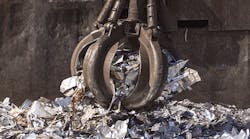New Report: U.S. Recycling Workers Exposed to Safety Hazards and High Injury Rates
A new study, released June 23 by environmental, occupational safety and community benefits experts in collaboration with researchers at the University of Illinois School of Public Health, finds that recycling work is “unnecessarily hazardous” to workers’ health and safety. Seventeen American recycling workers died on the job from 2011 to 2013. Recycling workers are more than twice as likely to be injured at work as the average worker.
By ensuring health and safety compliance across the industry, the study’s authors say cities can create good and safe recycling jobs, and they offer concrete policy recommendations for cities.
"Recycling is the right thing to do, but we have to do it the right way," said Mary Vogel, executive director of the National Council for Occupational Safety and Health. "That means educating and empowering recycling workers, and using proven prevention strategies which we know will reduce exposure to hazardous conditions. That’s how we can avoid tragedies like the death of a recycling worker just last week in Florida.”
Key findings from the report, Safe & Sustainable Recycling: Protecting Workers Who Protect the Planet, include:
- The industry’s high injury and fatality rates are a result of unsafe working conditions around heavy machinery and exposure to hazardous items on the sort line, like hypodermic needles, toxic chemicals and animal carcasses.
- Many waste and recycling companies heavily rely on temporary workers, who have fewer workplace protections and are less likely to be informed of their legal right to a safe and healthy workplace.
“People put dangerous stuff in recycling bins,” said Mirna Santizo, who worked at a Casella recycling facility for 12 years, sorting recycling from Boston and other cities. “We found lots of broken glass and needles. Sometimes workers were punctured and hurt from the needles.”
To create good and safe recycling jobs, the authors recommend:
- City governments evaluate the health and safety records of recycling companies and require these companies to have comprehensive worker safety programs,
- The recycling industry ends the use of temporary workers, and
- Cities enact strong community education programs for greater household separation of waste to minimize dangerous contaminants entering the recycling stream.
“Many cities have figured out how to collect recycling in ways that help our environment, and create good, safe jobs. It's time to extend that approach to every city, and to every step of the recycling chain, starting with recycling sorting facilities,” said Hays Witt with the Partnership for Working Families, a report contributor.
Most recently, a Florida man was crushed to death on June 15in a cardboard compactor while working at a recycling plant in Winter Garden, outside of Orlando.
“If we are serious about solving the world’s ecological crises, we need to invest in protecting the lives and livelihoods of workers whose daily efforts are reducing pollution, conserving precious resources and mitigating climate change,” said Monica Wilson of GAIA, a contributor to the report.
“Safe and Sustainable Recycling” is being released with events in 10 cities. The report notes important economic and climate benefits from expanding recycling nationally, including climate benefits equivalent to shutting down one-fifth of U.S. coal power plants and sustaining a total of 2.3 million jobs. That is more than 10 times the number of jobs created by sending the same material to garbage incinerators and landfills.

